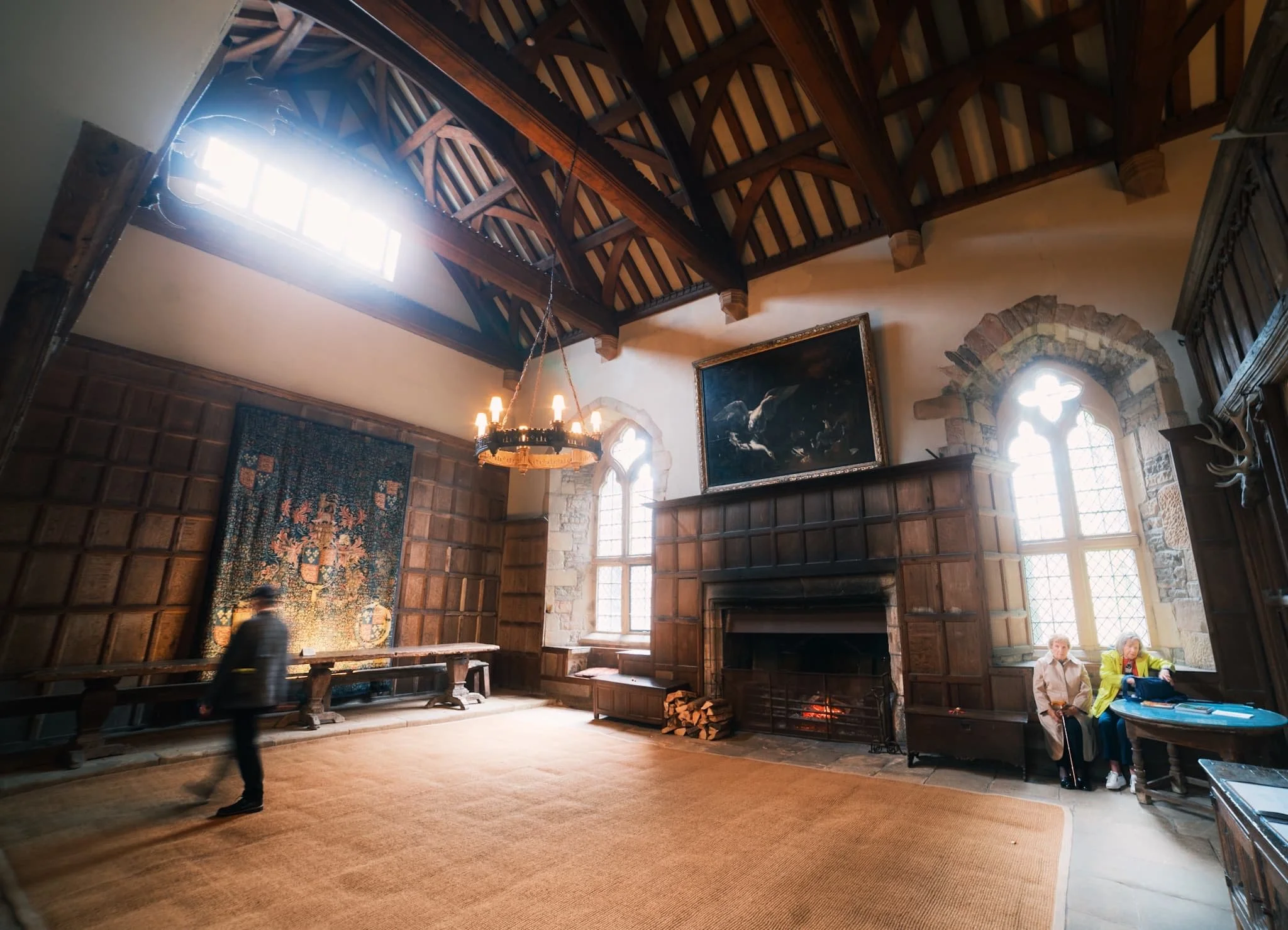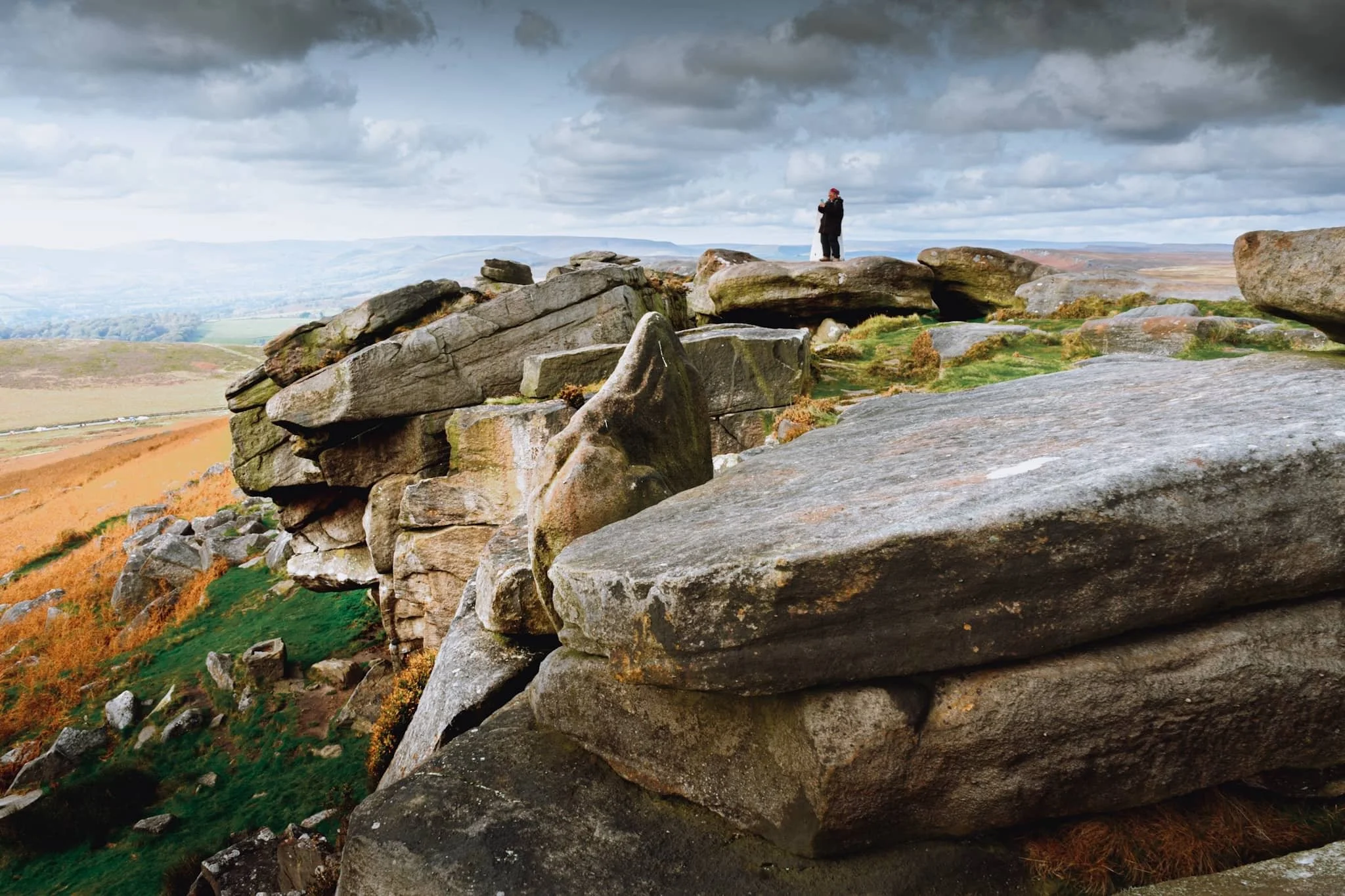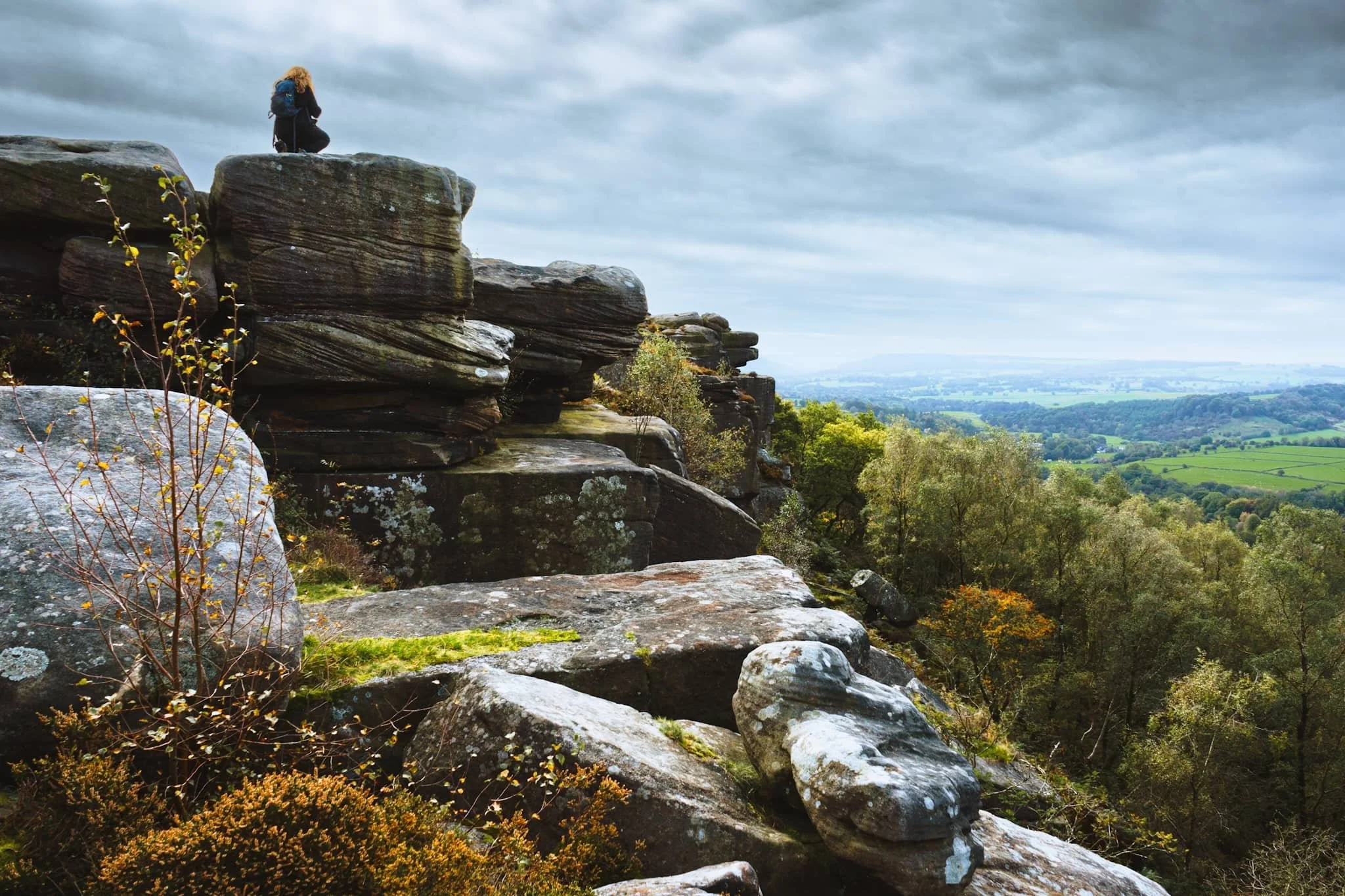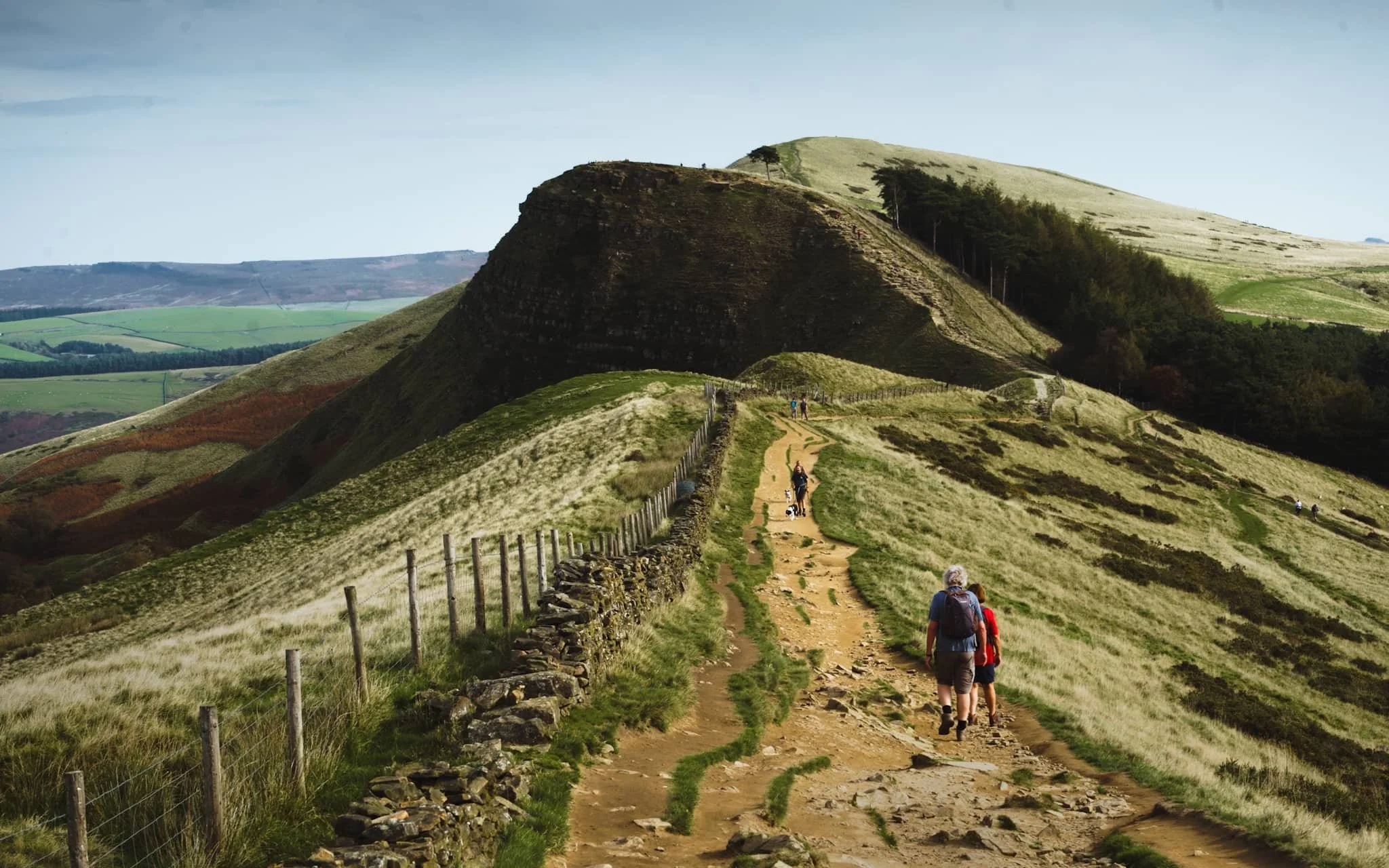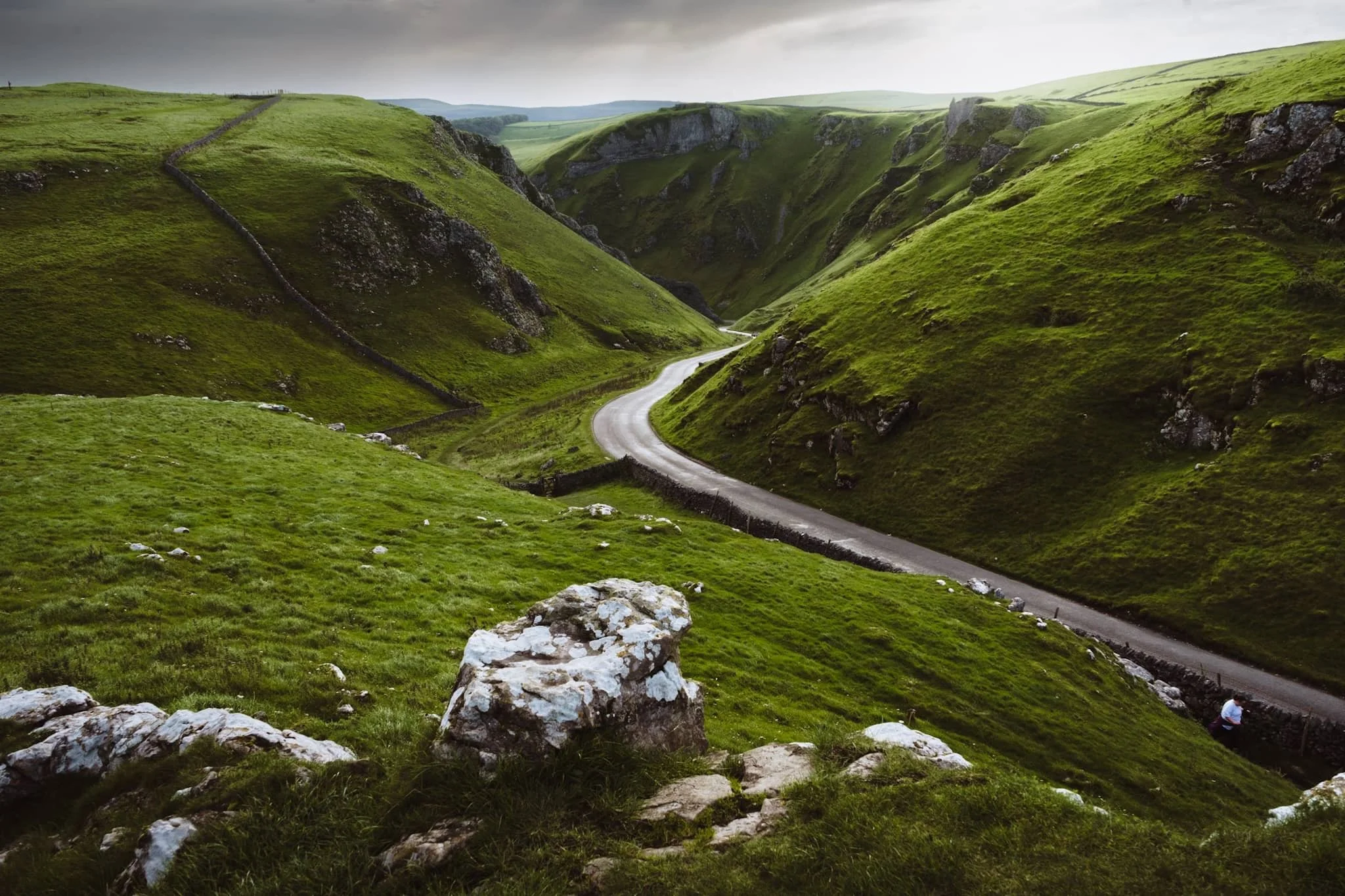Haddon Hall, Derbyshire, Autumn
Towards the end of Peak District foray, we decided it was time for something more historical.
Towards the end of Peak District foray, we decided it was time for something more historical.
Lisabet had zeroed in on a grand building near Bakewell known as Haddon Hall. It has been described as “the most complete and most interesting house of its period”. The origins of the hall are from the 11th century, with additions at various stages between the 13th and the 17th centuries, latterly in the Tudor style. Due to the building becoming uninhabited for two centuries until the 1900s, a lot of its tudor and medieval heritage has survived the modernisation of the Georgian and Victorian periods.
It’s been used extensively as a location for filming, including in Treasure Houses of Britain; The Princess Bride; the BBC's adaptation of The Silver Chair; Jane Eyre; Elizabeth; Pride & Prejudice; A Tudor Feast at Christmas; Time Crashers, and Gunpowder.
It’s definitely not a cheap place to visit, but the grounds and hall are absolutely fascinating and incredibly well preserved. I had a lot of fun with my 14mm ultra-wide lens.
All photos taken on my Sony α7ii using my Rokinon 14mm f2.8 ED AS IF UMC ultra-wide prime lens. RAWs developed in Lightroom using Cobalt Image’s Fuji Classic Neg profile.
Haddon Hall, Derbyshire, Autumn by Ian Cylkowski is licensed under CC BY-NC-SA 4.0
The entrance to Haddon Hall’s Lower Courtyard. The main entrance to the Banqueting Hall, built in the 1300s, can be seen to the left.
The way in to the Banqueting Hall, where tour guides are ready to present the story and history of Haddon Hall to visitors (including us).
The main kitchen, west of the Banqueting Hall. It dates from around 1370 CE. The multiple fireplaces would’ve baked bread and spit roasted meats.
The pantry, located in between the kitchen and Banqueting Hall, also built in the 14th century. You can imagine carcasses being hung up on tenter hooks, another being butchered on the wooden slab, whilst butter was being churned elsewhere.
The Buttery, also built in the 14th century. Stone floor and walls would’ve kept the room cool enough to all manner of dairy products to be made and stored here.
The Banqueting Hall, built in 1370 CE, so it is truly medieval. It remains furnished with its original Dais table, behind which hangs a tapestry gifted to the family by a visiting Henry VIII.
The Great Chamber was a Solar or Solarium, otherwise known as "an upper chamber of a mediaeval house". It was completed between 1540 and 1567 and served as a drawing room. It has a 16th Century plaster frieze round the top of the walls, bay windows overlooking the gardens and Flemish tapestries depicting woodland scenes.
A small little study in between the Great Chamber and the Long Gallery.
The Long Gallery of Haddon Hall, perhaps the most filmed part of the entire building. In contrast to the Tudor and Medieval Rooms below, the light and airy first floor Elizabethan rooms culminate in this spectacular 110ft Long Gallery, reputed to be one of the most beautiful rooms in England.
Above the fireplace, a painting of Haddon Hall itself, situated in the landscape. The Long Gallery dates back to about 1600 CE and its panelled walls and plaster ceiling are decorated with the coats of arms of the Vernon and Manner’s families.
The way to the Ante Room and State Bedroom. The panelling and carving above the door frame shows the Manners Peacock, standing proudly over the pediment and one of the crests.
Looking back down the Long Gallery in all its light and airy splendour.
The Ante-Room in between the Long Gallery and the State Bedroom. Tapestries decorate the walls. The walls all throughout Haddon Hall would’ve been covered in tapestries. However, the family’s most prized tapestries were stored in the stables, which is where a huge fire started in 1926, destroying most of them.
Now no longer in use as a bedroom, instead an intricately carved handmade snooker table sits in this room, decorated with tapestries and flooded with light.
The terraced 17th century gardens. Often regarded as an English interpretation of a 16th century Italian garden. Haddon Hall’s Elizabethan walled gardens are a rare survival of the 16th century.
The Hall’s walls around the gardens are covered in a wide variety of climbing roses.
Not a bad little place for a spot tea, hmm? The doorway is our next entrance, towards the Parlour.
For less formal occasions, the Parlour would be the dining room instead of the Banqueting Hall. Large windows were regarded as a costly luxury in mediaeval times. Large areas of glass could not be viably produced other than by combining smaller, often diamond-shaped, pieces held together with lead beading. These days the Parlour can be booked for weddings.
Making our way back to the Banqueting Hall, we crossed the Lower Courtyard to the Chapel of St. Nicholas. It’s a small humble building with Norman origins. The present building was finished in 1427 CE.
The chapel boasts a rare series of medieval wall paintings, most likely commissioned in the early 15th century. The paintings were whitewashed during the Reformation, but became visible in the 19th century and were restored in the early 20th century.
Exquisite and very rare 15th century fresco seccos adorn the walls of the Medieval Chapel.
One last look back across the footbridge to Haddon Hall. You can imagine a horse and cart, carrying esteemed guests, making their way towards the Hall.
Did you enjoy these photos?
Buxton, High Peak, Derbyshire
Buxton. Spas. Spring water.
Buxton. Spas. Spring water.
A certainty on our itinerary when holidaying in the Peak District was to explore the historical spa town of Buxton.
Though almost slap-bang in the middle of the Peak District, Buxton isn’t actually in the National Park. Look…
Buxton, in the Peak District area
Image courtesy of VisitBuxton.co.uk.
This means Buxton has excellent links to other parts of the National Park.
Buxton has been inhabited since the Stone Age, but the first major development of the area came courtesy of the Romans. They named the settlement Aquae Arnemetiae, that is, "Baths of the grove goddess".
Various peoples throughout history have treasured Buxton for its natural geothermic spring, which constantly gushes water out at a steady 28ºC. The town grew in the 18th century due to the Dukes of Devonshire, but it was really in the Victorian era where Buxton drew the crowds. Touring Victorians were attracted to the reputed healing powers of the natural spring.
We enjoyed a long and pleasant meander around the town, on what turned out to be a wonderfully clear autumnal day. Buxton really showed off what it had to offer.
All photos taken on my Sony α7ii using my Sony FE 28–70mm f3.5–5.6 OSS zoom and Rokinon 14mm f2.8 ED AS IF UMC prime lenses. RAWs developed and edited in Lightroom for iPad using Digistock’s Ektar 100 profile.
Buxton, High Peak, Derbyshire by Ian Cylkowski is licensed under CC BY-NC-SA 4.0
We first wandered around Buxton Park before entering the town proper. Beautiful autumn colours were really starting to pop all around the park. Geese were plentiful, too, and clearly very accustomed to humans.
A fellow tourist takes in the view across one of the many ponds and lakes in the park. In actuality, these ponds are all part of the River Wye, which was heavily landscaped in the 19th century.
The park and Pavilion Gardens were opened in 1871, designed by Edward Milner, a well-known landscape architect. He also developed three parks in Preston, Lancashire, amongst many others.
Another lovely English scene, full of ducks, meticulously maintained landscaping, and Victorian architecture.
Buxton Opera House was designed by Frank Matcham in 1903. It’s reportedly the highest opera house in the country. Matcham also designed several London theatres, including the London Palladium, the London Coliseum, and the Hackney Empire.
Buxton saw a decline as a spa resort in the early 20th century. The Opera House re-opened in 1979 with the launch of the Buxton Festival, and the town saw rejuvenation as a base for exploring the Peak District.
Part of the Pavilion Gardens is this 19th century conservatory. Originally, the building was used as a small concert hall, complete with organ. In 1982 it was remodelled as a greenhouse conservatory, with tropical plants and a fish pond.
The Conservatory now houses many beautiful plants, several of which are extremely rare to find anywhere else in the UK.
A visit of Buxton is not complete without checking out St. Ann’s Well and the Pump Room. The room was built in 1894 to dispense the well's water from taps for drinking. Now restored and managed as a Tourist Information Centre, I shot this 10-shot panorama to really take in the Victorian architecture.
Buxton Town Hall, opened in 1889, was designed in the style of a French château. It now houses the offices of High Peak Borough Council.
Around the corner from the Opera House, we found this wonderfully preserved piece of living history: a Victorian chemists’. The shop assistant even showed us a ledger they’ve kept of patients and their prescriptions all the way back to the Victorian times.
The crowning jewel of Buxton: the Crescent. It is often compared to the more famous Royal Crescent in Bath, but some argue that Buxton’s is “more richly decorated and altogether more complex”.
The Crescent was built in the late 18th century for the 5th Duke of Devonshire. His plan was to elevate Buxton into a popular Georgian spa town. It was built as a unified structure incorporating a hotel, five lodging houses, and a grand assembly room with a fine painted ceiling. By the mid-1980s the last part of the Crescent that was still functioning as a hotel closed due to the high cost of necessary repairs. Then, the whole building was closed when major structural problems were discovered in 1992.
What followed was a couple of decades of the building changing hands, fundraising for essential repairs and upgrades, and consulting on its future. Finally, in October 2020, Ensana reopened the hotel following 17 years of refurbishment.
Did you enjoy these photos?
Stanage Edge, Peak District, Autumn
Perhaps the Peak District’s most famous edge.
Perhaps the Peak District’s most famous edge.
Froggatt Edge and Curbar Edge were epic enough. But further north, above the bonny village of Hathersage, one can find the massive 3.5-mile long Stanage Edge, which peaks at High Neb 458 m (1,503 ft).
Aside from the height and length of Stanage Edge, and its epic views plus incredible rock formations, the escarpment is famous for rock climbing. Any of the crags and rock walls are not particularly high, perhaps up to 25 m in height, but they are challenging and have been tackled extensively from the mid-20th century onwards.
Thankfully access to Stanage Edge is easy courtesy of numerous small, and free, carparks and road laybys. With the addition of high winds and ever-changing light, we enjoyed an epic hike along this most famous Dark Peak edge.
All photos taken on my Sony α7ii using my Sony FE 28–70mm f3.5–5.6 OSS zoom lens. RAWs developed and edited in Lightroom for iPad, with a little finalising help using Darkroom for iPad.
Stanage Edge, Peak District, Autumn by Ian Cylkowski is licensed under CC BY-NC-SA 4.0
Upon ascending the trail from the off the road, the views immediately open up across the expansive moorland towards Over Owler Tor.
At the trig point 457 m/1,499 ft a. s. l., my Lisabet climbs up to capture those seemingly endless panoramas towards Edale and the Hope Valley.
Smoothed gritstone boulders line the way towards the trig point. Happily, cloud formations above endeavoured to provide another leading line to the trig point.
A drop between two walls provides a nice composition as the light explodes from the clouds, illuminating Over Owler Tor in the distance.
The sun almost completely out, I find a solitary boulder perched precariously on the edge of a gritstone platform.
I crept underneath an overhanging crag that provide me this lovely arrangement of boulders with a view towards Burbage Moor. Fighting the 50+ mph wind gusts, I carefully place the trail below the edge in between the boulders and the crag for a clean leading line.
Further north along Stanage Edge I found a few large gritstone boulders, beautifully smoothed and carved by millennia of erosion. They put me in mind of tortoise shells.
A set of beautifully smooth boulders huddle together against the powerful winds. In the distance, you can just make out Hope Valley with Mam Tor and the Great Ridge rising above.
Lisabet enjoyed making me nervous by standing perilously close to the edge of several severe drops. They did, however, make for excellent photos.
Below Stanage Edge the sharp drop down gives way to miles of fern and bracken, now displaying their rusty autumnal hues as they creep up the escarpment wall.
This was about as close to the edge as I dared, in order to nab a composition with these rock formations, like piles of messily stacked CDs.
Above Hook’s Car, the drop from Stanage Edge is more vertiginous and clearly an area where rock climbers like to upgrade their skills. People to the bottom-left of the image and on top of the edge to the right show the scale of the place.
This was a particularly popular climbing section, with one climber recently ascending to the top of the edge and victoriously pulling up his rope.
From here, it’s actually possible to make out where the White Peak limestone of the Hope Valley gives way to the eastern Dark Peak gritstone.
There were a few of these boulder bridges spanning across gaps that provided lovely little “portal” style compositions to play around with.
Dark Peak landscapes aren’t really known for their caves, like the White Peak is, but there’s a famous one on Stanage Edge: Robin Hood’s Cave, pictured here with people enjoying the shelter and relief from the wind. Did Robin Hood ever rest in this cave? Who knows?
One of my favourite shots from the day, showing the sheer vertical drop down from Stanage Edge, and the full extent of its length into the distance.
Two pillars of gritstone stacks provide another “portal” composition looking across the moorland towards the Peak District’s limestone plateau.
A wider composition, with Stanage Edge continuing on into the distance on the right. In the middle, Bamford Moor gives way to the rolling hills above Derwent Reservoir.
We located one of the main trails down the escarpment and back towards the road. About halfway down, I couldn’t escape this arresting composition. Miles of rusty ferns with Stanage Edge and clouds above.
Did you enjoy these photos?
Froggatt and Curbar Edges, Peak District, Autumn
If there’s one thing that the Peak District has a lot of, it’s Edges.
If there’s one thing that the Peak District has a lot of, it’s Edges.
The Peak District can roughly be divided into two areas: the White Peak, and the Dark Peak. The naming is based on the underlying geology: the White Park is limestone, and the Dark Peak is gritstone.
You’ll find the Peak District’s edges exclusively in the Dark Peak, particularly the eastern part of the National Park. From below, they appear has formidable walls and cliffs with fantastical rock formations and crags. Beyond those crags usually lies acres of boggy moorland.
On this particular occasion, we decided to explore every nook and cranny of two of the more famous edges: Froggatt Edge and Curbar Edge. They form a near-continuous route, north to south.
The day was bright, much cooler, and clear, save for the creeping clouds that gradually covered the sun as the day went on. Nevertheless, the scenes were absolutely sublime.
All photos taken on my Sony a7ii using my Sony FE 28–70mm f3.5–5.6 OSS and Vivitar “Series 1” 70–210mm f2.8–4.0 zoom lenses. RAWs developed and edited in Lightroom for iPad, finalised in Darkroom for iPad.
Froggatt & Curbar Edges, Peak District, Autumn by Ian Cylkowski is licensed under CC BY-NC-SA 4.0
Starting from the north, the first part of the walk involves a beautiful woodland, Froggatt Woods, full of silver birch and autumnal ferns.
Emerging out of the woods, the views quickly open up and we find our first clump of gritstone boulders to climb around. Lisabet immediately hopped on one for a better view.
Already my excitement levels build as a veritable playground of compositions and rock formations present themselves to me.
A smooth nook in this boulder provided a nice foreground composition, with other crags forming a lead line towards the distant Upper Derwent Valley.
Lisabet’s woodland elf-like abilities means she easily clambers up to the highest boulder to nab those special photos. For me, her slight frame provides wonderful context for the scene.
An isolated pillar of a crag, whipped into otherworldly shapes by millennia or wind and rain, provides a lovely subject for this composition of heather, tors, and across the valley.
Navigating through the various crags and boulders, a little gap catches my eye. As peep through it, a sheer cliff wall down to the valley floor makes my stomach grip. And of course, I snap a photo to convey this sudden drop.
There’s not much separation between Froggatt and Curbar Edge. However, the drop from Curbar Edge is even more severe. This gap between two walls of gritstone provides a lovely leading line towards Baslow Edge in the distance.
Clambering on top of the some of the crags, these beautifully smoothed boulders with deep fissures provide a paradise of compositions, which I line up with Baslow Edge far away.
The staggeringly sheer drop down from the top of Curbar Edge is a sensation I’ll never forget.
This was about as close as I dared to the edge of the precipitous fall to the valley bottom from Curbar Edge.
A stronger burst of sun pulls out all the detail and texture in these windshaped crags.
The amount of heather up on Curbar and Froggatt Edge makes me realise that I need to come back here in late summer, when the heather’s vibrant magenta flowers will carpet the landscape.
Two neighbouring boulders, blasted by wind and rain for millennia, give another gorgeous composition to shoot as stronger sunlight emerges.
Quarrying has occurred on the Peak District’s various edges for centuries. The hard-wearing gritstone made for great millstones, used to grind grain like oats, barley and rye or other feedstuffs.
A lady rests in a nook on Curbar Edge, taking in the panoramic views whilst talking on her phone. She gave the scene a wonderful sense of context and scale that I couldn’t ignore.
Another isolated pinnacle of gritstone catches my eye. As the sun emerges again from the clouds, I line up this composition, using the various boulders to point a zigzagging route to the pinnacle.
Great slabs of gritstone with fissures and covered in lichen allow me to draw another composition looking north as the sun bathes the scene.
After we stopped from lunch using a boulder as shelter, we head back north along the trail. I equip my longer 70–210 mm lens to try and nail some zoomed in, tighter compositions. Here, from the edge, I zoom in on Stony Middleton nestled in its deep limestone gorge.
I enjoyed zooming in on the fell side as it caught the light; the land neatly divided by drystone walls, as a contrast to the pillars of rough gritstone.
Did you enjoy these photos?
Winnats Pass & Mam Tor, Peak District, Autumn
Time to revisit more familiar areas.
Time to revisit more familiar areas.
Last time we attempted to explore Winnats Pass and Mam Tor was way back in May 2015. Back then I was considerably heavier and unfit. Since then I’ve lost a lot of weight and gained fitness. It would be interesting to see how I would fare tackling these locations compared to last time.
Our day started in bonny Castleton, heading west to the foot of Winnats Pass and hiking up the pass alongside the road, a 20% gradient uphill. After reaching the top, we would then continue up the moorland to locate the Mam Tor trail. Then it’s simple enough to follow the path to the summit, along the Great Ridge and then down the valley to Castleton.
Though the tops were windier than in the past few days, it was still unreasonably hot for an October day, pushing 21ºC. In any case, the light was compliant and the views were astounding.
All photos taken on my Sony α7ii using my Sony FE 28–70mm f3.5–5.6 OSS zoom lens. RAWs were developed in Lightroom for iPad, finalised in Darkroom for iPad.
Winnats Pass & Mam Tor, Peak District, Autumn by Ian Cylkowski is licensed under CC BY-NC-SA 4.0
The impressive limestone crags above Winnats Pass dominate the skyline as you make your way up.
Looking back down Winnats Pass from roughly halfway up, the sun starting to rise above the gorge walls.
We found an isolated crag that gave us a solid composition looking down the pass. The name “Winnats” is a corruption over time of the original name “Wind Gates” Pass, due to the howling winds that funnel through the gorge.
From the top of the pass, it was easy enough to head up the moorland and locate the Mam Tor trail. Even just climbing up the trail a little bit, the views back down to Rushup Edge are already superb.
Around the shoulder of Mam Tor, the views towards Edale and Kinder Scout above are stunning. Aided, in part, by the winding road as a lovely leading line.
On the way up Mam Tor, the view back towards Winnats Pass reveals the dramatic drop of the gorge. It was once believed to be a giant collapsed cave, but evidence suggests it formed around an underwater canyon. Over time, other rocks covered this area. Much later, erosion revealed the pass we see today, shaped by melting water finding weak points in the rock.
As we climb higher, I find a sheep on the shoulder of Mam Tor, seemingly enjoying the views towards Edale.
Beyond the summit of Mam Tor, at 517 m / 1,696 ft above sea level, our next goal was clear in front of us: Hollin’s Cross and Back Tor along the Great Ridge.
Near Hollin’s Cross, fellow hikers rest and take the time to enjoy the extensive panoramic views across Edale.
Looking back along the ridge from Hollin’s Cross reveals profile of Mam Tor. The hill is also known as Shivering Hill, as its southeastern face near-constantly sheds rocks and causes landslips. In fact a long-established road underneath this side of Mam Tor, the A625, was abandoned in 1979 due to the constant need to repair the road after landslides.
Beyond Hollin’s Cross, our next destination was unmistakeable: the hulking crag of Back Tor.
Back Tor has similar geology to Mam Tor, and as such what you see is the result of a large shale landslip that falls dramatically down to the valley floor of Edale.
After falling on my arse a few times navigating the muddy trail down from the Great Ridge (and getting punctured by gorse on both occasions), I’m relieved to finally locate a paved country lane. Happily, it was also a nice composition to record.
From almost everywhere in Castleton, the towering crags of Winnats Pass are never far away.
Friends enjoy a pint outside the Bulls Head, whilst Mam Tor’s southeastern face rises clearly in the distance.
